M
I
C
R
O
S
T
O
R
Y
O
F
A
R
T
........................................................

NOW COMPLETED:

........................................................
MICROSTORY OF ART
ONLINE JOURNAL FOR ART, CONNOISSEURSHIP
AND CULTURAL JOURNALISM
........................................................
INDEX | PINBOARD | MICROSTORIES |
FEATURES | SPECIAL EDITIONS |
HISTORY AND THEORY OF ATTRIBUTION |
ETHNOGRAPHY OF CONNOISSEURSHIP |
SEARCH

........................................................



 >MICROSTORIES
>MICROSTORIES
- Richard Serra
- Martin Scorsese
- Claude Simon
- Sunshine
- Werner Herzog
- The Creation
- Marcel Duchamp
- Nino Rota
- Wölfflin and Woolf
- Hansjörg Schneider
- Kraftort Arkadien
- Visual Biography
- Schlaraffenleben
- Die Geisteswissenschaften
- The Voyeur
- Buzzword Sustainability
- Paul Verlaine
- Tao Yuanming
- New Beginning
- Seneca
- Still Lifes
- Charles Baudelaire
- Frédéric Chopin
- The Art History of Sustainability
- Wang Wei
- Solarpunk
- Historians of Light
- Lepanto
- Renaturalization
- Plates
- Snow in Provence
- Learning to See
- Picasso Dictionaries
- Peach Blossom Spring
- Picasso Tourism
- Tipping Points
- Sviatoslav Richter
- Weather Reports
- Treasure Hunt
- Another Snowscape in Picasso
- Picasso in 2023
- Dragon Veins
- The Gloomy Day
- The Art of the Pentimento
- Reforestation
- The Status of Painting
- Emergency Supply
- Punctuality
- Watching Traffic
- Zhong Kui
- How Painting Survived the 1990s
- Confirmation Bias
- Sustainability and Luxury
- Garage Bands
- Picasso and Artificial Intelligence
- Eyes of Tomorrow
- Picasso in 2023 2
- Gluing Oneself to Something
- Suburbia
- Bamboo
- Sustainability and Carpe Diem 1
- Interviews with Bruegel
- Sustainability and Carpe Diem 2
- Coffee & Sugar
- Bamboo 2
- Picasso in 2023 3
- Sustainability and Carpe Diem 3
- Cherry Orchard
- Old Magazines
- Chance
- Nick Drake
- Harlequin
- The Smartphone & the Art Book
- Atlas Syndrome
- The Kitchen
- Atlas Syndrome 2
- Consideration
- Tori Amos
- School
- Orchard Auctioning Day
- The Hundred Years’ War
- Sócrates
- Chameleon
- Nefertiti Bust
- Picasso as a Computer
- Sunflowers
- Philemon & Baucis
- Ode to the Radio
- Childhood
- Wimmelbild
- Restitution
- Nick Drake 2
- Wishful Thinking
- Sundays
- The Independent Scholar
- September
- The Fisherman by Pirosmani
- Microadventure
- Sociology
- Salvator Mundi
- Chillon
- Appassionata
- Amber
- Homer
- Berlin
- Planet Walk
- Improvisation
- Seeing Picasso
- These Nice Kids
- Robber
- The One
- The Sea Turtle
- Zoo
- Through the Hush
- Wunderkammer
- I Do Not Seek, I Find
- Shopping Mall
- Food Hamper
- The Secretary
- This Gate
- Nor Rainy Day
- House on a Hill
- Beautiful Island
- Second-hand Bookstore
- Flat
- Slap in the Face
- Serra, Wenkenpark
- Apologies
- The Bells
- Nordmann Fir
- Picasso Wanting To Be Poor
- Picasso, Pirosmani
- A Brief History of Sculpture
- 24 Sunsets
- Rusty Phoenix
- Glove
- Wintry Stanza
- A Song
- Like A Beatle
- Catching An Orange
- Solar Bees
- Permaculture

 >FEATURES
>FEATURES
- Van Gogh On Connoisseurship
- Two Museum’s Men
- Ende Pintrix and the City in Flames
- Titian, Leonardo and the Blue Hour
- The Man with the Golden Helmet: a documentation
- Un Jury d’admission à l’expertise
- Learning to See in Hitler’s Munich
- Leonardo da Vinci and Switzerland
- The Blue Hour Continued
- The Blue Hour in Louis Malle
- Kafka in the Blue Hour
- Blue Matisse
- Blue Hours of Hamburg and LA
- A Brief History of the Cranberry
- The Other Liberale in the House
- The Blue Hour in Raphael
- Who Did Invent the Blue Hour?
- Monet on Sustainability
- Velázquez and Sustainability
- The Blue Hour in Guillaume Apollinaire
- Van Gogh on Sustainability
- The Blue Hour in Marcel Proust
- Picasso and Sustainability
- The Contemporary Blue Hour
- The Blue Hour in 1492
- The Blue Hour in Hopper and Rothko
- Hopper and Sustainability
- The Blue Hour in Ecotopia
- The Hour Blue in Joan Mitchell
- Explaining the Twilight
- The Twilight of Thaw
- The Blue Hour in Pierre Bonnard
- Explaining the Twilight 2
- Picasso on Stalin
- Rubens on Sustainability
- The Salvator Mundi in Bruegel and Rubens
- The Blue Hour in Leonardo da Vinci and Poussin
- The Blue Hour in Rimbaud
- Faking the Dawn
- Frost and Thaw in Ilya Ehrenburg
- Picasso, Stalin, Beria
- Picasso, Solzhenitsyn and the Gulag
- Shostakovich on Picasso
- Hélène Parmelin in 1956
- Historians of Picasso Blue
- Picasso Travelling to Moscow 1
- The Blue Hour in Caravaggio
- Picasso Travelling to Moscow 2
- Picasso, the Knife Game and the Unsettling in Art
- Some Notes on Leonardo da Vinci and Slavery
- Picasso Moving to the Swiss Goldcoast
- The Blue Hour in Camus
- The Blue Hour in Symbolism and Surrealism
- Caspar David Friedrich in His Element
- Exhibiting the Northern Light
- Caspar David Friedrich in His Element 2
- Robert Schumann and the History of the Nocturne
- The Blue Hour in Robert Schumann
- Caspar David Friedrich and Sustainability
- The Twilight of Thaw 2
- Multicultural Twilight
- The Blue Hour in Anton Chekhov
- The Blue Hour in Medieval Art
- Twilight Photography
- The Blue Hour in Bob Dylan
- Iconography of Optimism

 >SPECIAL EDITIONS
>SPECIAL EDITIONS
- Visions of Cosmopolis
- Mona Lisa Landscapes
- Turner and Ruskin at Rheinfelden
- Painters On TV & On TV
- Spazzacamini in Art
- A Last Glance at Le Jardin de Daubigny
- The Experimental Cicerone
- A Dictionary of Imaginary Art Historical Works
- Iconography of Blogging
- Begegnung auf dem Münsterplatz
- Cecom
- Das Projekt Visual Apprenticeship
- Those Who See More
- A Fox on Seeing with the Heart
- Sammlung Werner Weisbach
- Daubigny Revisited
- Some Salvator Mundi Microstories
- Some Salvator Mundi Afterthougths
- Some Salvator Mundi Variations
- Some Salvator Mundi Revisions
- A Salvator Mundi Questionnaire
- A Salvator Mundi Puzzle
- Unknown Melzi
- Francis I and the Crown of Charlemagne
- From Amboise to Fontainebleau
- Drones Above Chambord
- Looking Back At Conques
- Flaubert At Fontainebleau
- Images of Imperial Ideology
- The Chronicles of Santa Maria delle Grazie
- Seeing Right Through Someone
- Melzi the Secretary
- Eying Glass
- A Foil to the Mona Lisa
- A Renaissance of the Cartoon
- Sketching a Family Tree
- Venetian Variations
- A Brief History of Digital Restoring
- A Consortium of Painters
- Leonardeschi and Landscape
- A Christ in Profile
- Learning to See in Spanish Milan
- A History of Gestures
- Leonardo and Josquin
- A Renaissance of the Hybrid
- Suida and Heydenreich
- The Watershed
- Three Veils
- From Beginning to End
- Connoisseurship of AI
- Twilight and Enlightenment
- The Blue Hour in Chinese Painting
- Dusk and Dawn at La Californie
- Iconography of Sustainability
- The Blue Hour in Goethe and Stendhal
- The Sky in Verlaine
- The Blue Hour in Paul Klee
- Iconography of Sustainability 2
- The Blue Hour in Charles Baudelaire
- From Bruegel to Solarpunk
- Some Salvator Mundi Documentaries
- Some More Salvator Mundi Monkey Business
- The Windsor Sleeve
- Brigitte Bardot’s Encounter with Picasso
- Art Historians and Historians
- A Salvator Mundi Chronicle
- The Salvator Mundi and the French Revolution
- The Fontainebleau Group
- The Encounter of Harry Truman with Pablo Picasso
- The Fontainebleau Group Continued
- The Windsor Sleeve Continued
- The Salvator Mundi in Early Netherlandish Painting 1
- Some Salvator Mundi Resources
- A New Salvator Mundi Questionnaire
- The Woman in Picasso
- The Yarborough Group
- Melzi, Figino and the Mona Lisa
- The Yarborough Group Continued
- A Salvator Mundi Global History
- The Salvator Mundi in Medieval Art
- The Salvator Mundi in Medieval Art 2
- The Salvator Mundi in Early Netherlandish Painting 2


 >HISTORY AND THEORY OF ATTRIBUTION
>HISTORY AND THEORY OF ATTRIBUTION
- The Mysterious »Donna Laura Minghetti-Leonardo«
- Assorted Demons of Connoisseurship
- Panofsky Meets Morelli
- Discovering the Eye of Sherlock Holmes
- Handling the Left-handed Hatchings Argument
- Visual History of Connoisseurship
- Alexander Perrig
- Connoisseurship in 2666
- What Postmodernity Has Done to Connoisseurship
- Dividing Four Fab Hands
- A Leonardesque Ambassador
- Test Cases in Connoisseurship
- A Raphael Expertise
- How to Tell Titian from Giorgione
- Louise Richter
- The Unique Property in the History of Connoisseurship
- An Expertise by Berenson
- The Book of Expertises
- An Album of Expertises
- An Expertise by Friedländer
- A Salvator Mundi Provenance
- How to Tell Leonardo from Luini
- An Expertise by Crowe and Cavalcaselle
- An Expertise by Bayersdorfer
- An Expertise by Hermann Voss
- An Expertise by Hofstede de Groot
- Leonardeschi Gold Rush
- An Unknown »Vermeer«
- An Expertise by Roberto Longhi
- An Expertise by Federico Zeri
- A Salvator Mundi Geography
- A Salvator Mundi Atlas
- The Bias of Superficiality
- 32 Ways of Looking at a Puzzle
- James Cahill versus Zhang Daqian
- Five Fallacies in Attribution
- On Why Art History Cannot Be Outsourced to Art Dealers
- On Why Artificial Intelligence Has No Place in Connoisseurship
- Salvator Mundi Scholarship in 2016
- Leonardo da Vinci at the Courts
- The Story of the Lost Axe
- The Last Bruegel
- A Titian Questionnaire
- On Where and Why the Salvator Mundi Authentication Did Fail
- The Problem of Deattribution

 >ETHNOGRAPHY OF CONNOISSEURSHIP
>ETHNOGRAPHY OF CONNOISSEURSHIP
MICROSTORY OF ART
ONLINE JOURNAL FOR ART, CONNOISSEURSHIP
AND CULTURAL JOURNALISM
........................................................

***
ARCHIVE AND FURTHER PROJECTS

1) PRINT


***
2) E-PRODUCTIONS


........................................................

........................................................

........................................................
FORTHCOMING:


***
3) VARIA

........................................................

........................................................

........................................................

........................................................

........................................................
***
THE GIOVANNI MORELLI MONOGRAPH

- The Giovanni Morelli Monograph
........................................................
MICROSTORY OF ART
ONLINE JOURNAL FOR ART, CONNOISSEURSHIP AND CULTURAL JOURNALISM
HOME
MICROSTORY OF ART ONLINE JOURNAL FOR ART, CONNOISSEURSHIP AND CULTURAL JOURNALISM Twilight and Enlightenment  |
See also the episodes 1 to 29 of our New Salvator Mundi History:
Francis I and the Crown of Charlemagne
The Chronicles of Santa Maria delle Grazie
A Brief History of Digital Restoring
Learning to See in Spanish Milan
And:
Twilight and Enlightenment
(23.-24.10.2021) We had begun this History by looking at a late work by Raphael and his workshop in the Vatican. And this is
also where we will have this History to end. By looking at another work of this other all-too-well-known-unknown,
whose works in the Vatican are of such striking complexity, having rather little to do with the popular image of Raphael.
Actually this image and these works are worlds apart, and this applies also to the last work of Raphael, the
Transfiguration, whose lighting is of such striking complexity. And in this 30. episode of our New Salvator Mundi History
(chapters 31 and 32 will be ›reprints‹ of texts I had written ealier, which can be regarded here as an annex), in this
last episode of the main text of this History, we will look at ways of lighting, of types of light, ranking from the
limelight to the rather dim but lively candlelight, in which a medieval reliquary can be set and staged in. Will there be
enlightenment, at the end of this New Salvator Mundi History? I dare to predict that we will be experiencing further
what we are also experiencing with the Transfiguration by Raphael: we will have to face hybridity of lighting,
hybridity of light. And, yes, enlightenment may be possible, but there is also the question of how optimistic one might
be, in terms of enlightenment once and possibly overcoming the twilight of doubt, myth, fallacy, mediocrity of
scholarship and, yes, of gigatons of rubbish circulating. We face the choice of what light, of which light we might
accept as our personal guiding light in Salvator Mundi matters. Since the establishment of Leonardo studies has shown
uncapable or unwilling to solve a problem, to clarify a matter, we actually have anarchy in this particular field of the
humanities. A telling anarchy, with no authorities, no shining lights, indicating the way to the truth. And so this last
episode is about light, but it is also about what the Salvator Mundi question is about in its core. Because it is not
about a painting alone, and not about attribution alone. It is about the ideal of truth, and how it is handled – by
whomever. It is about the state of scholarship and about the state of the public sphere and its institutions. Brief: it
is about the sociology of knowledge today. And this truth should not be clouded by atmospheric phenomena. It is about the
ways knowledge is being produced, handled, spread, debated, respected or not, questioned or not, accepted or not. And
this is a bigger matter that the truth of what a (rather mediocre) painting is. In truth.
(Picture below: detail of a photo of the Transfiguration by Raphael; photo: flickr.com/Buster&Bubby).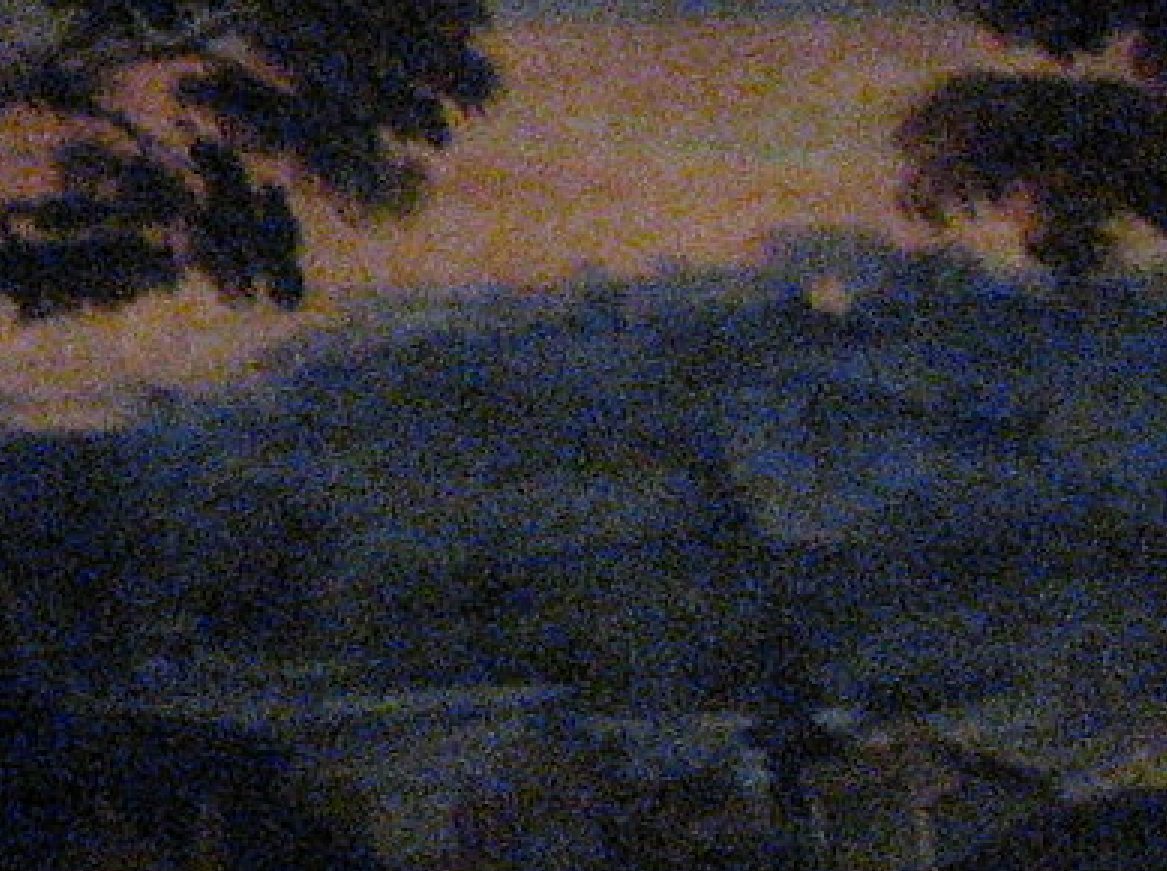
One) The Blue Hour in Raphael
The Transfiguration shows so-called ›Taborlicht‹, ›Tabor light‹, the light seen, by few witnesses, while the transfiguration
of Jesus took place, on Mount Tabor. But the painting actually synthesizes three scenarios: the actual transfiguration (with
Tabor light), the scenario seen in the foreground (the attempted curing of a boy from demons, which takes place during
the night and might be thought as being lighted by moonlight, perhaps enhanced by the scene evoked above, perhaps
artificially and only intellectually), and a slim landscape background (on the right). The latter seems to be represented
while dawning: the sun is about to come up, but has not yet come. But the blue hour, with much blue light in the
atmosphere while the sun is still above the horizon, is passing or already has passed. Yet the color blue seems still to
figure in that area of the painting (compare the picture above).
But it is also difficult to assess the colors and the lighting, since – as also is the case with works by Leonardo – each
photograph seems to show the actual painting in a new light (the Virgin of the Rocks by Leonardo, for example, can extremely
differ, in its atmosphere, in various photographic reproductions). But this is also interesting, because it reminds, indirectly,
how subjectively we do look. I am reminded, for example, by Tabor light, that when I had been a small child, my father,
being away on an excursion in Israel, had sent me postcards from Israel. And one postcard had been a bird’s eye view of
Mount Tabor. Another view I hardly can, and above all, I don’t want to leave aside, while looking at (representations of)
the Transfiguration by Raphael. The detail above is deliberately chosen to illustrate, in its pixel structure, the
artificiality of photographs. We might see what I am calling twilight here, but it is actually a combination of colored
pixels, a picture showing the way to abstraction (or to medieval art; compare the example below), but in its abstraction
of color fields still can be associated with a blue hour passing or having passed.
The blue hour is a phenomenon named only, as it seems, in the 19th century (at least this is our hypothesis), while it,
the phenomenon, must always have been there for humans, and humans have always given the period of dusk and dawn some
special meaning, by associating it with reflection, and even (as Stanley Kubrick did, in an epic cinematic artwork), by
associating it with the awakening of humankind (if some tribe does awake, it means the awakening of all, after some time).
One does wonder, how Raphael and his workshop might have thought about the meaning of dawning or the phenomenon of blue
light in the atmosphere, before the sun was coming up. Was it associated, for them, with the cleared state of mind, after
spiritual meditation? Or was it just some marginal thing to do, in a religious picture, even something that was handed
over to a member of the workshop. But lighting, the aspect of lighting is a crucial part of what one might call
›directing‹ or ›staging‹. And we should take another look at some seemingly marginal aspect in some Salvator Mundi
versions and at the way they are lit.

Two) Lit From Above
To me the Christ of Salvator Mundi version Cook appears as if he has just found a gap to appear. The picture
frame seems narrow, while the Christ of the Wenzel Hollar etching (above left) appears massive, and as someone who is
inhabiting that gap (if, here, the frame, is thought as such). I have never been much convinced that Wenzel Hollar ever
had seen version Cook – and the abbreviation of this very thought, a code, if one likes to say so, was, among Salvator Mundi
obsessed people, the code of ›Hollar never met Cook‹.
What I find striking, is, and it still seems to be little discussed, that version Cook is lit from the upper left side
of the picture, while the Hollar etching – if one might speak of ›lit‹ –, it is lit from the upper right. Which can be
seen, as well as the question can be decided, by studying the pattern of light and dark at the chest of Christ. We see,
again, that version Cook, in its cleaned state, is not that easy to decipher, but it seems clear that the dark shadowy
parts are on the right side of the chest, and this means that the light is coming from the upper left.
Hollar might have had difficulties too, to respect the given space he had for his pictorial representation, but he must have
virtually changed every detail of the picture, if he worked after version Cook, and also the way it is lit. And I
don’t think that, after changing virtually every aspect of the picture he copied, he still would have felt entitled to
ascertain that, once, Leonardo had painted what he had just copied. It is simply another picture, even the margin on the
right side is also narrow (as in version Cook). This might have another explanation, other than a direct causality between
two pictures (similarity is not necessarily causality). If someone else had reworked a representation that, assumingly,
had been done after version Cook, the someone who did copy the second generation copy would still have faced similar
problems with the narrowness of the frame. And since Hollar, decidedly, had voted for a massive presence of Christ in the
picture frame, the problem with the narrowness of picture space might have become more delicate. But it is, literally,
a marginal problem, and compared to the changing of how the picture is lit, it seems a trifle more trivial than to change
the lighting (as well as many other things).


Three) Sfumato and Sfumato Myths
Do we have a clear idea of what sfumato is, or what the very term does mean? Specialist do know (or should know)
that Leonardo da Vinci himself did not use that term at all. And in my view we should in the first place beware to
equal sfumato with chiaroscuro. But this is, as it seems, happening all the time. If, for a moment, we would
replace sfumato with ›atmospheric effects‹ (such as dust, haze or smoke), we would become aware that sfumato
cannot work without light and dark, but it is not the same thing as light and dark. And I wonder if one might detect
sfumato, if one would search for sfumato, in the Christ by Salaì (shown on the right). In my view the
Salvator Mundi does not display sfumato at all, nor does the Christ by Salaì. Both are pictures, instead,
that can traced back to the portrait style of Antonello da Messina, but do not – do not – display atmospheric effects
(such as smoke, haze or dust). And since Christ is representing Lux mundi this would also not make much sense at all.
I don’t know whether the restoration had been guided by the idea to produce sfumato effects, but I do neither see
sfumato in the cleaned-state-image of the Salvator, nor in pictures of the restored one. I also cannot understand
why the hair should be in sharp focus (as Ben Lewis has observed), while other parts on the same plane should not be.
Such clues could be interpreted as further clues that the picture is a hybrid, because, as we have seen, inconsistencies
can be signs of hybridity, but the the face of Christ in the cleaned-state-picture cannot be ›read‹ anyway. So at best
one might hypothesize that there once was sfumato intended. But, again, this would be only hypothetical, because it rests
on a hypothesis only. And an alternative one might be the view that abrasion has produced a structure that those who
are expecting to see sfumato – in a late style work by Leonardo – have interpreted as such.
A similar problem is caused by the blessing hand. Frank Zöllner who seems to be willing to represent the faction of
sceptics in the public sphere, but who, on the other hand, has not substantialized his view by actual scholarship, has
called the blessing hand ›pallid and waxen as in a number of workshop pictures‹. But which pictures? Why not naming
them? Why not saying on what comparisons such opinion is based? And this I mean by not having substantialized mere
opinion, based on some observations and knowledge of what others have written or said, by actual scholarship: because
if Zöllner had – silently – been referring to the Detroit Salvator Mundi, or to the Warsaw version, both pictures
that, until recently and still by many, are regarded as being workshop pictures, this would mean that he had associated
version Cook with a late 16th century work – while for many the quality of the blessing hand in version Cook is actually
the main reason to associate the picture with Leonardo at all (I am agreeing with those who call the blessing hand the
best part of the picture, in terms of quality). ›Pallid and waxen as in a number of workshop pictures‹ versus ›best
preserved and possibly autograph‹ is worlds apart, and as a result we are facing – twilight.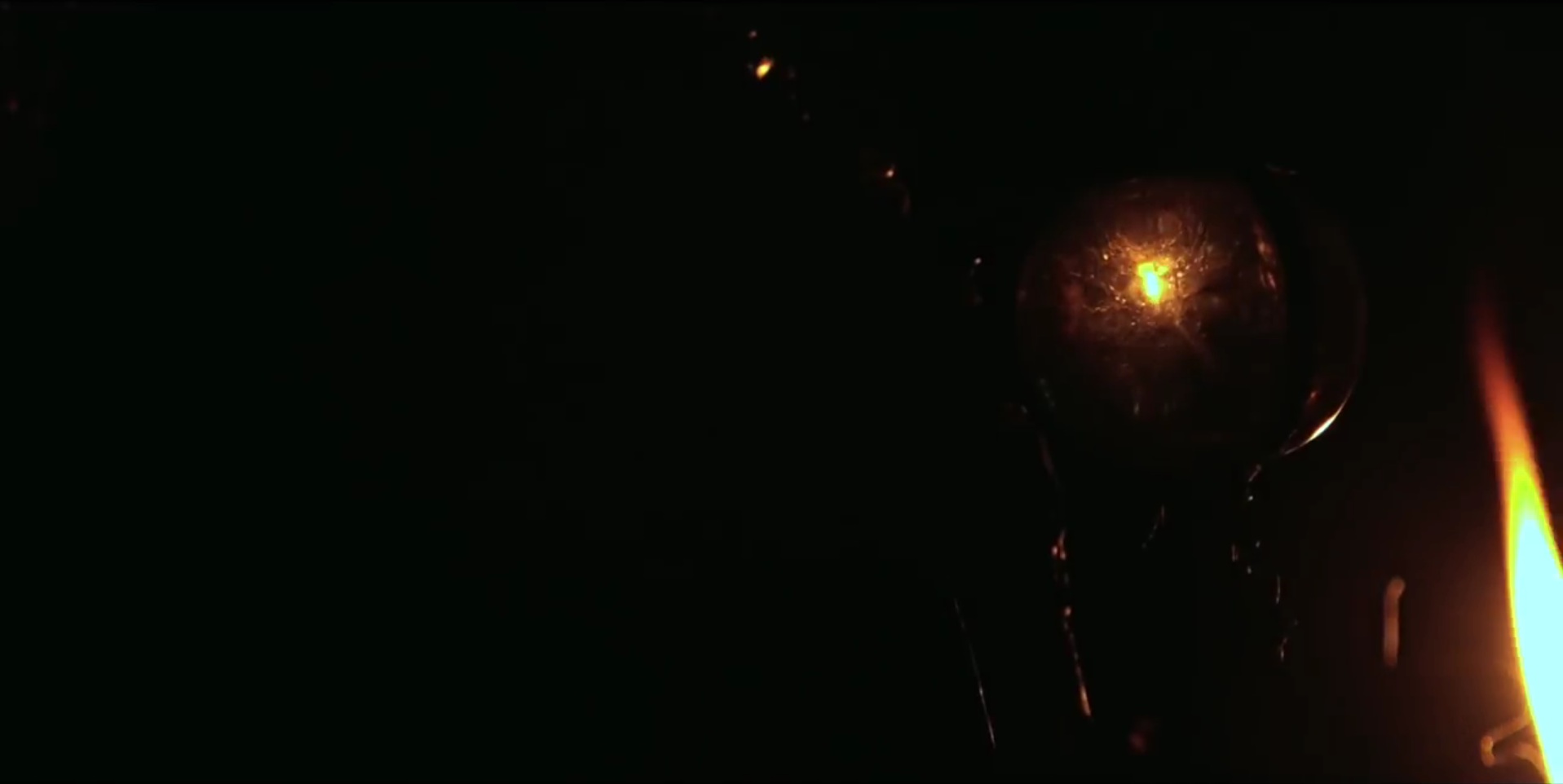
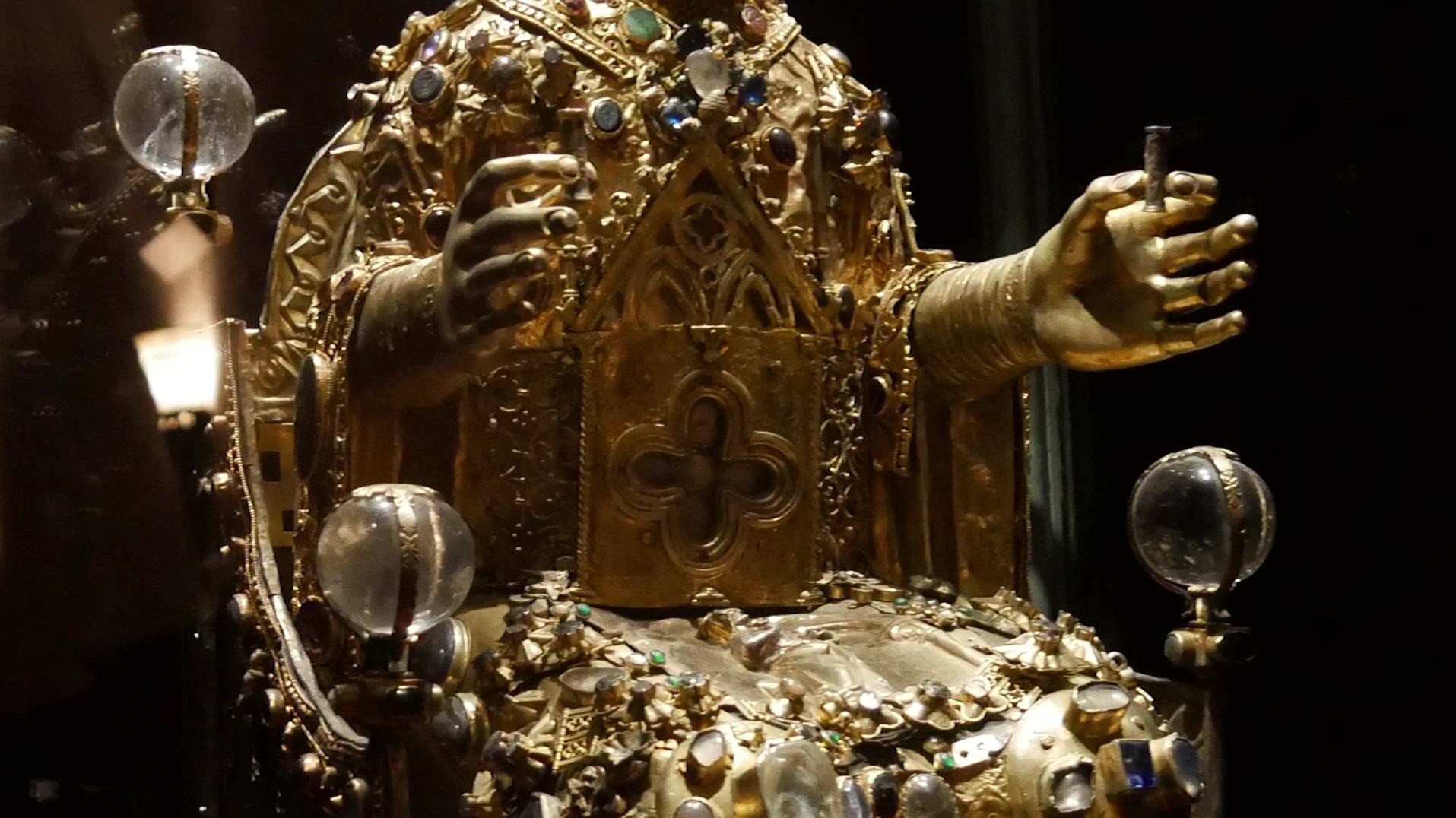
Four) Private Candlelight and the Political
Candlelight might be associated with intimacy, and also with the privacy of meditative spirituality, or, as we have
seen in the Conques episode, with more or less public religious life in and around churches. It is a warm light, and it
contrasts with the idea that the Salvator Mundi orb, in its essence, is a symbol of rule, but it not necessarily
contradicts the idea. If the picture was meant to be seen in the context of private devotion, we simply see a symbol of
rule in such context, but I have wondered, in further episodes, if the picture should be depoliticized – in the
context of our interpretation.
It might have been a picture for a ruler or regent, or it might not have been such picture, but it is not essentially a
picture without any political dimension, since also in a private context Christ holding an orb is not a depoliticized
motif, even if, in such context, one might ignore the symbol of rule as well. But art historians and historians,
contemplating possibilities of interpretation, should not.
However, it certainly does exist an anonymous, but powerful expectation (enhanced by ways of marketing), to contemplate,
even to enjoy the beauty of a masterpiece only without thinking about intricate religious meanings the picture might have
had initially. We have many extremes meet in the Salvator Mundi saga, and one such meeting of extremes, of opposites,
and one of the most interesting paradoxa, inherent to that saga, is the contradiction that we are meant to enjoy beauty,
genius, while actually not a few people do feel uncomfortable with the picture. One does wonder, if this is due
to the direct gaze of Christ – I have called it piercing and inquisitory, and pointed to the Dominican context, which,
plausibly, might be the context of origin. Or it might be due to the confrontation with religious images as such, coming
from an age that lived in and with religion (while we are living rather with, but not often, perhaps, in
religion).
I tend to think that the unconfortable feeling of many viewers might be due to the fact that we still are sensing, even
if we would consider ourselves to be agnostics, that the gaze of Christ – perhaps an inquisitory gaze – is intruding our
private sphere, the private sphere of, let’s say, agnostics. And if this is true, the Salvator Mundi never was a
depoliticized picture, neither it is one now. Because this picture seems to think our privacy to be political, and it
does intrude such privacy by a piercing gaze. If such view of the picture is compatible with a mere enjoying of the
beauty of an alleged masterpiece, I would doubt. But the expectation to thus perceive the picture has definitively been
enhanced, even if marketing strived also, occasionally, at enhancing the view of the picture being a spiritual one,
almost staging it in candlelight as well, but in the context of marketing. Many extremes are meeting here. Enlightenment
might be possible, if we are attempting to name these extremes. The ›spiritual counterpart of the Mona Lisa‹ (an
unspeakably misleading and in its essence ill-conceived slogan, in my view), for others, had been ›the idiot brother of
the Mona Lisa‹. The Christ we see had not been restored based on the idea that we might see a Grand Inquisitor as
having been imagined by Dostoevsky rather, but a Jesus that could be friend with anyone, a Big-Lebowski-dude. Such ideas
are not compatible at all. But in the existing twilight, everything seems possible. Anything goes, seemingly, and
extremes do, more or less peacefully, coexist.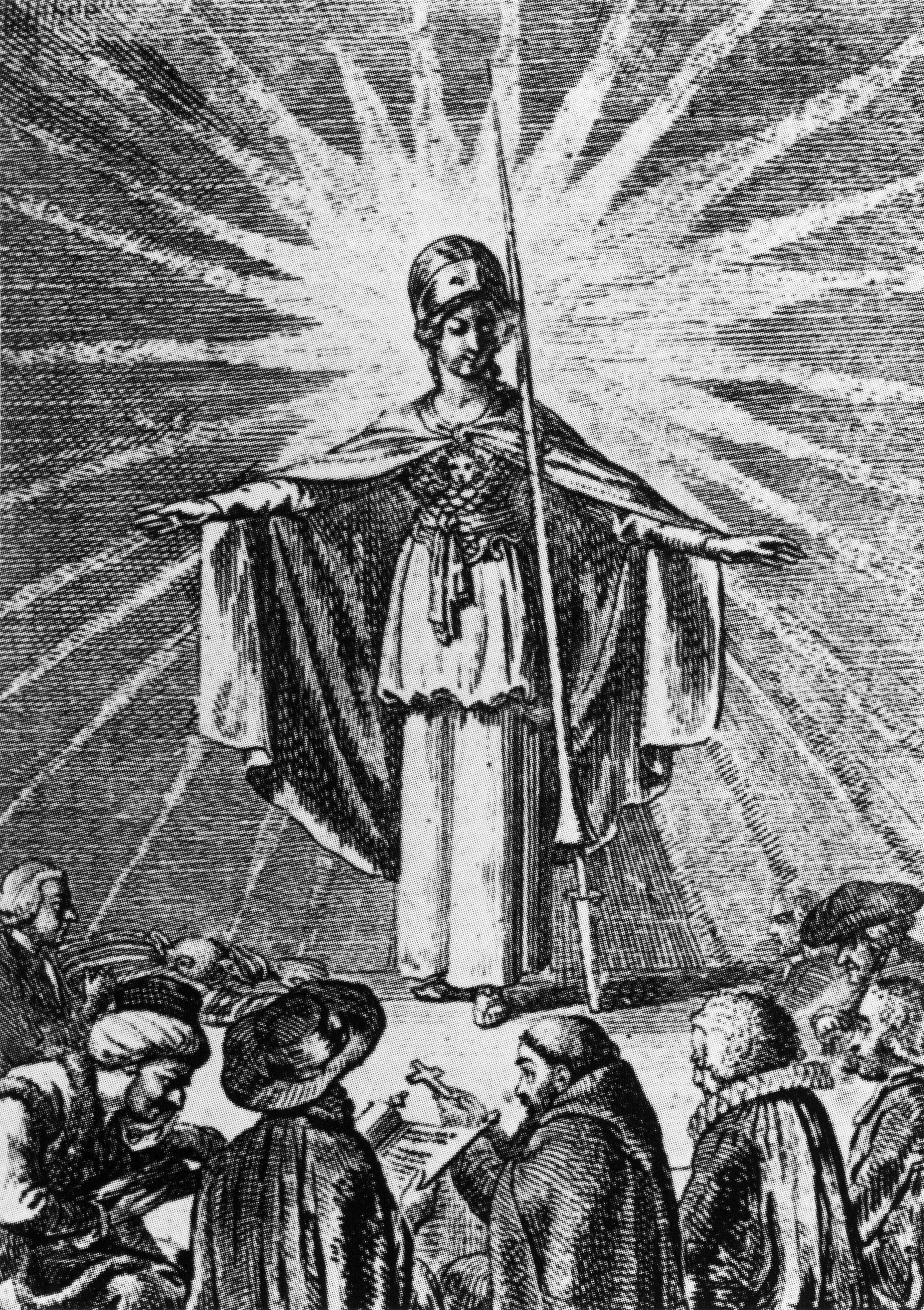
Five) Hybrid Light
This New Salvator Mundi History was written during the (miserable) summer of 2021 (which, still, had our single one apple
tree produce an enormous, unseen amount of apples) and finished in the (beautiful) autumn of 2021 (which saw us eating
as well as giving away many apples). At the end of this process I have to state that I do not wish to see the restored
Salvator Mundi or pictures of it anymore. I prefer to have the idea of this picture, of this painting freed from its
restoration which had been guided, in my view, by illusions and wrong ideas. Ordinary people, who do not know the details
of this process (but do the specialists know?) sense that there is something fishy in this story of a rediscovered
autograph work by Leonardo, which, in my view, is a Melzi-Leonardo-Salaì-hybrid that had been ›embellished‹ early by a
green background, ruined by later cleanings or restorations or iconoclastic acts, and restored, at the beginning of the
21st century, based on the idea that it must have been an autograph work. All this does not result in something ordinary
people can ever have faith in. In case the restoration is reversible, it should be taken off the painting. For the
moment, we can live with a cleaned-state-photograph, which, also, has its peculiarities. It is lit (?) from behind or
below the picture, and it also can be read or deciphered in many ways. I do not think that we see a great picture or one
that once had been great (to be called a masterpiece), but it is an interesting object with, in my view, a fabulous
history, which might silence also those who do not even perceive the painting to be a work of art. It is a footnote in
the history of art, a monstrous one perhaps, but still a footnote. But also a microstory that emcompasses much of
European history (from antiquity to the present day) and much of the history of art. The history of that painting should
be written from scratch (I had sensed in the summer), and my History is the attempt to do so.



The Bottega of Leonardo da Vinci
The picture of the bottega of Leonardo da Vinci is not as blurred as one might imagine (for details see Seidlitz 1935, p. 530; Marani 1998). We will focus here on the early and middle years (up to 1512), and not on the late years, and one might begin with saying that with Boltraffio and Marco d’Oggiono we see two figures enter the orbit of Leonardo at the beginning of the 1490s that we believe to know rather well. We also see Salaì enter the orbit, at a very young age, and we have, in addition to that, a couple of names, names of figures that we do not seem to know very well, or not at all (a Giacomo, Giulio Tedesco, Galeazzo). Last but not least we have the Giampietrino problem: Giampietrino enters the scenery, but it is a matter of controversy (as far as this question is debated at all), when, since also Giampietrino is still very young.
It is noteworthy that Marco d’Oggiono, already at the end of the 1480s, seems to have had an own apprentice, and that Marco and Boltraffio did create the Pala Grifi together (a picture today in Berlin; picture above), even before Leonardo began to work at The Last Supper in 1495. Due to the work of Janice Shell and Grazioso Sironi we today do know more about Francesco Galli, also called Francesco Napoletano, who did die in Venice as early as 1501. One might imagine that Galli went to Venice with Leonardo in 1501, and if Galli, during the 1490s, for example might have cooperated with Marco, we would have found an interesting perspective: since, if only one single picture of the Marco group would be associated with Francesco Galli/Francesco Napoletano, we would have a picture with hand option 2, a picture that must have been created before Galli died in 1501. Which would mean that hand option 2 must have existed early, and my theory of the pentimento in version Cook as a mere switching from (preexisting) option 1 to (preexisting) option 2 would be positively proven as well as the theory of the pentimento supposedly showing the creative energy of genius (changing his mind) would be definitively falsified.
Brief: in the 1490s Leonardo mentions once that he had paid ›two masters‹ (probably Marco and Boltraffio) for two years; and once that he had six bocche to feed (probably again Marco, Boltraffio, plus Salaì and some of the unknowns).
Below a rather early Marco picture (according to Janice Shell), the Young Christ Blessing of the Galleria Borghese:
And here is a picture (not the only known picture) by Protasio Crivelli, formerly the apprentice of Marco d’Oggiono (picture by Sailko; the date appears to be 1498; location: Naples, Museo di Capodimonte):
In 1501 (3.4.) Pietro da Novellara informs Isabella d’Este that Leonardo seems to live ›from day to day‹ (see Marani 1998, p. 14). And he has seen Leonardo intervening from time to time in portraits done by two of his garzoni (»fano retrati«). But who are these, and which portraits are these (if this would have been about a Isabella d’Este portrait, Pietro would have noted; and after the Sforza had been expelled, portraits of court ladies and courtiers made no sense)? After having written on the picture of a young woman in the Columbia Museum of Art in one of the last episodes, I would now suggest the following:
Leonardo might have done a portrait of a Sforza court lady in the early Milanese years (and still in the Florentine portrait style), a portrait in terms of a drawing or a cartoon. He might have begun also a painting, but since the Sforza court got expelled and exiled after the French invasion, he might not have finished such portrait. He might instead have used it for the instruction of his garzoni: the Columbia picture might have been the one begun by Leonardo (as he seems to have begun portraits with the face, as later in the Mona Lisa), a picture that he might have had a pupil finish, with him retouching it again, adding some lustre. The picture in a private Russian collection might be a second version that he had a pupil repeat (after the first version and the drawing, respectively the cartoon). The Columbia picture shows much gusto for the grotesque, the second version less so, but still to some degree. Thus we would see pictures that have their origins in the first Milanese period (and even in the early Florentine period), but were actually done later (after 1500). And Leonardo might have had a hand in the Columbia picture whose head with the hair as well as the ornated hair net superbly being modelled into the dark is of exquisite quality (as also a single one pearl is, while other pearls are rather mediocre as also the bust and the modelling of the dress is). We see, as I have attempted to show in episode 13, two pictures that fit into the context of Leonardo’s thinking and doing rather than into the context of Boltraffio’s autonomous work: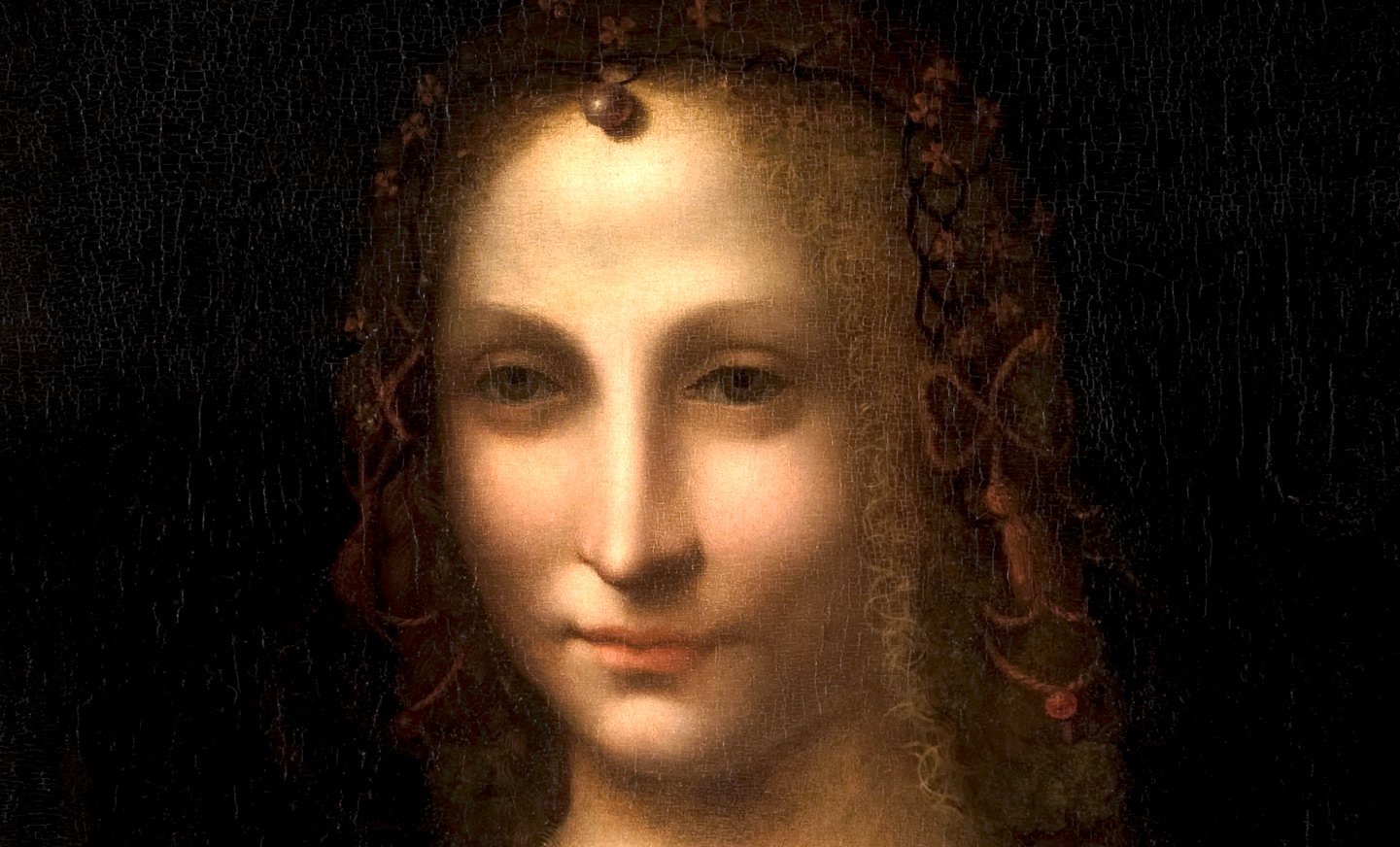
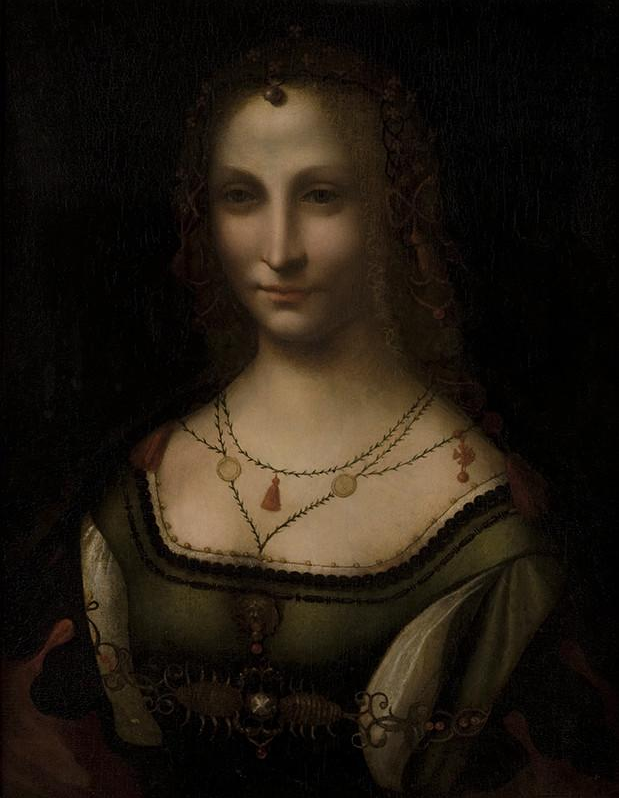
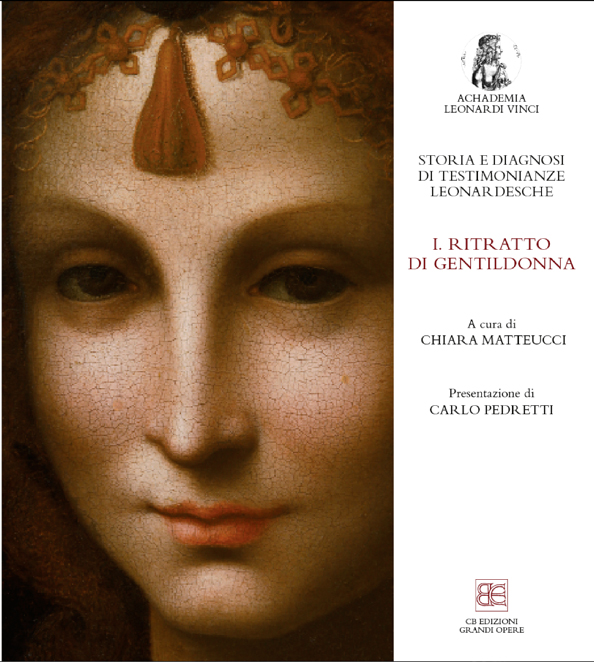
In 1504 a Jacopo Tedesco, in 1505 a Lorenzo (di Marcho) enter the orbit of Leonardo.
In around 1505 Fernando Yáñez enters the orbit of Leonardo, helping him with the Battle of Anghiari (as also does Riccio della Porta). Yáñez cannot be the author of the Prado Mona Lisa, if the Louvre Mona Lisa was finished only years later, since the dates (showing that Yáñez was active in Spain after 1506) do not allow to postulate it. In works of Yáñez done in Spain, however, we find echoes of Leonardo’s works (see the example below).
Around 1507 Francesco Melzi becomes a pupil of Leonardo (and also a sort of secretary).
In 1511 (or even earlier) Giampietrino is an autonomous master.
In 1511 Salaì seems to have created a (signed and dated) picture of Christ:
In around 1511 we see Marco, Boltraffio, Giampietrino and – Giovanni Agostino da Lodi in close contact, not only because we have a source indicating exactly that – we also have pictures indicating exactly that, and one of these pictures seems to be even dated (but the ›date‹ – ›XII‹ – is rather referring to the ›age of Christ‹):
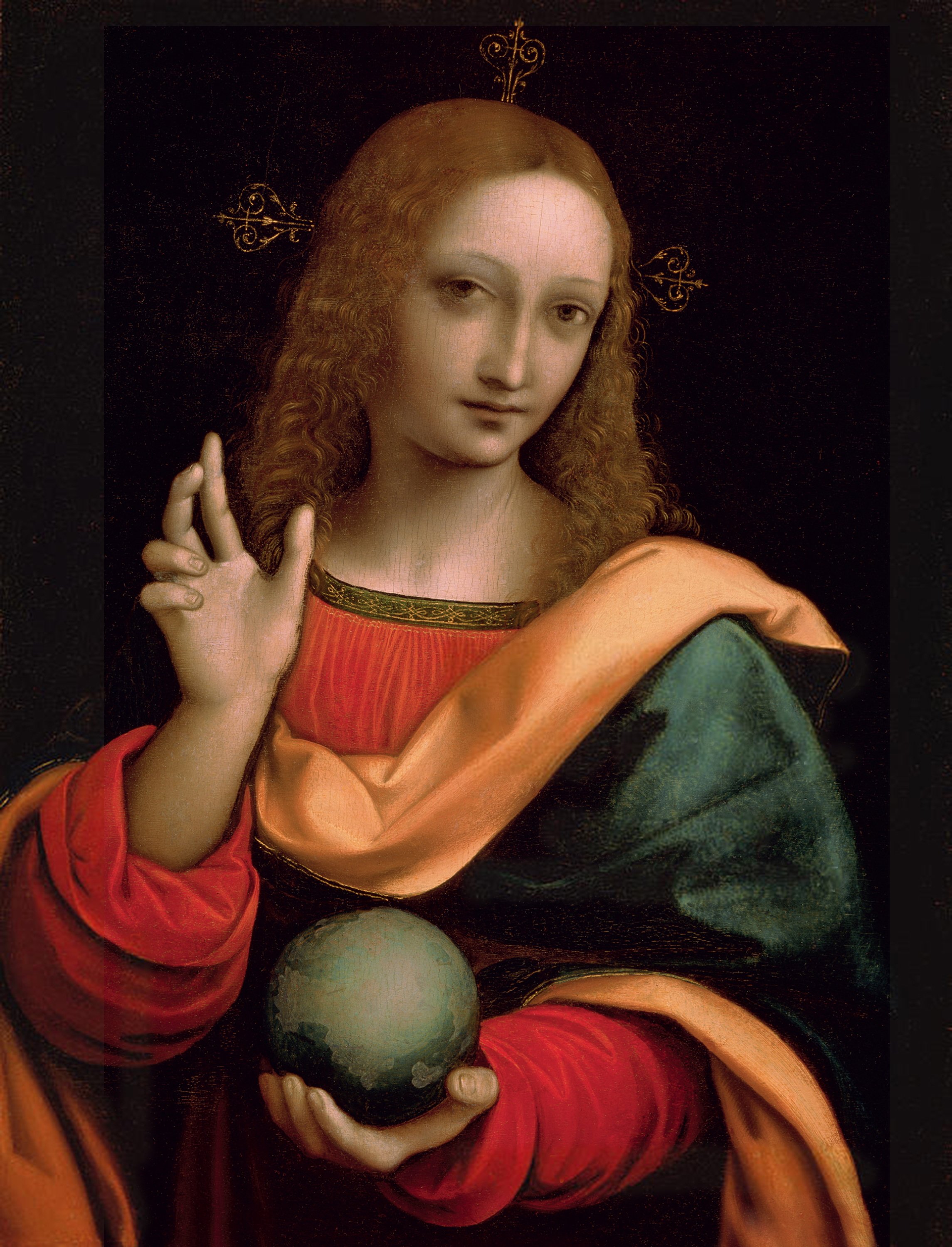
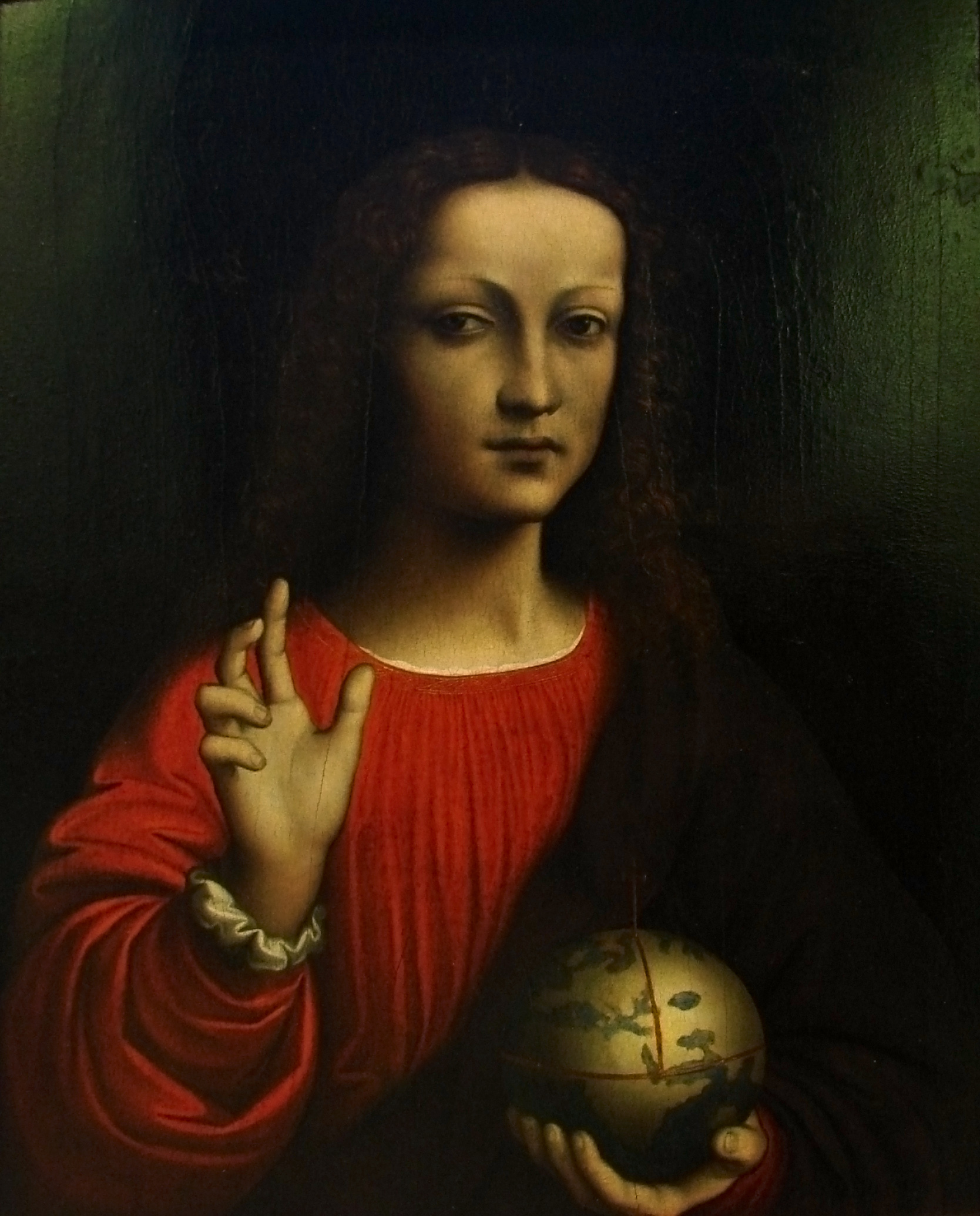
The Prado Mona Lisa (below) was probably begun at the time Leonardo also started reworking or completing the Louvre Mona Lisa, probably due to Giuliano de’ Medici wishing so, and hence perhaps in around 1511/12.
In around 1517 Marco d’Oggiono is cooperating with Giovanni Agostino da Lodi (see Shell, p. 173).
***
1516: Paolo Emilio, Italian-born humanist at the court of Francis I, publishes the first four books of his history of the Franks; death of Boltraffio.
1517: Leonardo da Vinci, with Boltraffio and Salaì, has come to France (picture of Clos Lucé: Manfred Heyde); 10.10.2017: Antonio de Beatis at Clos Lucé
1517ff: Age of the Reformation; apocalyptic moods; Marguerite of Navarre, sister of Francis I, will be sympathizing with the reform movement; her daughter Jeanne d’Albret, mother of future king Henry IV, is going to become a Calvinist leader.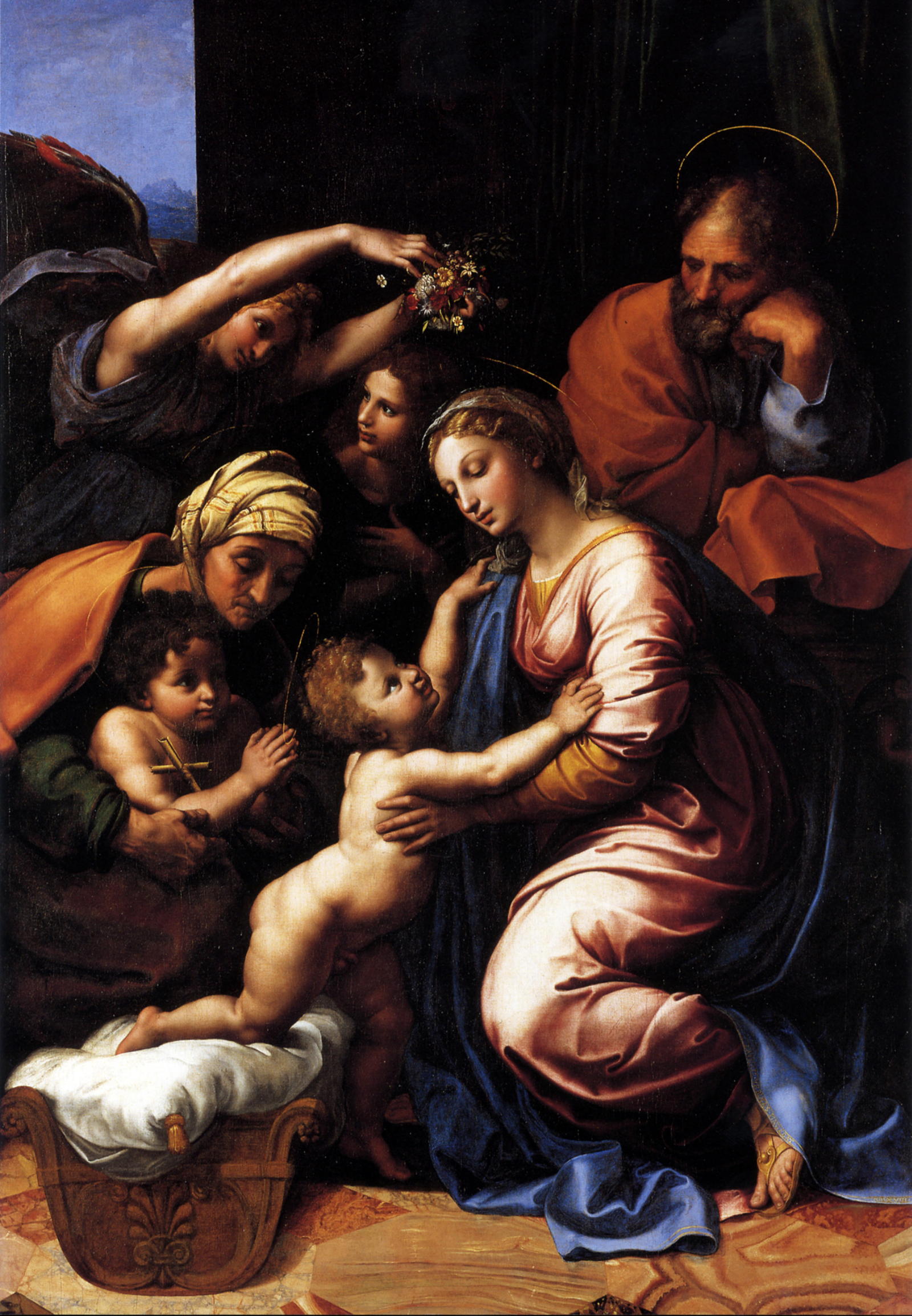
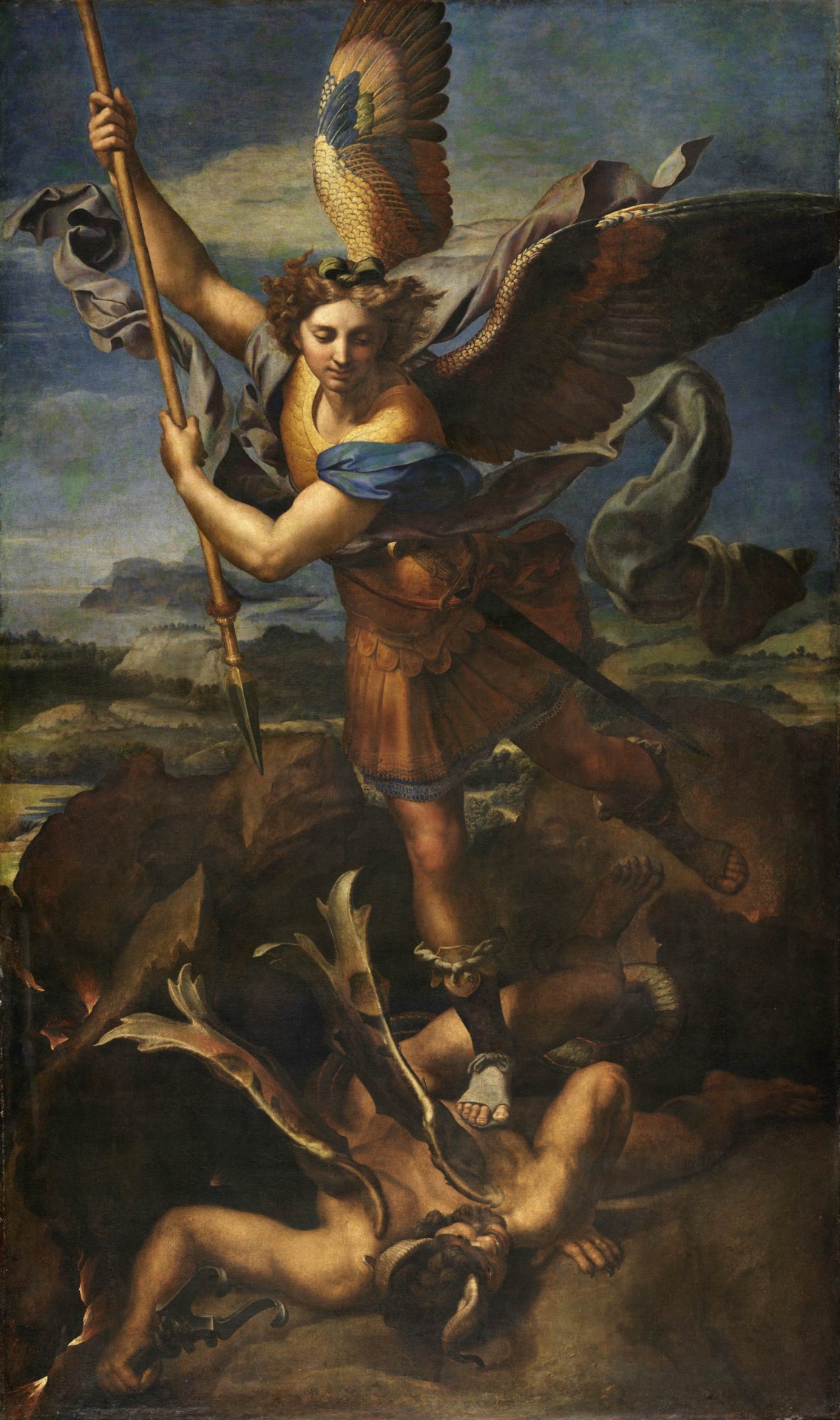
1518: the Raphael workshop produces/chooses paintings to be sent to France; 28.2.: the Dauphin is born; 13.6.: a Milanese document refers to Salaì and the French king Francis I, having been in touch as to a transaction involving very expensive paintings: one does assume that prior to this date Francis I had acquired originals by Leonardo da Vinci; 19.6.: to thank his royal hosts Leonardo organizes a festivity at Clos Lucé.
1519: death of emperor Maximilian I; Paolo Emilio publishes two further books of his history of the Franks; death of Leonardo da Vinci; Francis I is striving for the imperial crown, but in vain; Louise of Savoy comments upon the election of Charles, duke of Burgundy, who thus is becoming emperor Charles V (painting by Rubens).
1521: Francis I, who will be at war with Hapsburg 1526-29, 1536-38 and 1542-44, is virtually bancrupt.
1523: death of Cesare da Sesto.
1524: 19.1.: death of Salaì after a brawl with French soldiers at Milan.
1525: 23./24.2.: desaster of Francis I at Pavia. 21.4.1525: date of a post-mortem inventory of Salaì’s belongings.
1528: Marguerite of Navarre gives birth to Jeanne d’Albret (1528-1572) who, in 1553, will give birth to Henry, future French king Henry IV.
1530: Francis I marries a sister of emperor Charles V.
1531: death of Louise of Savoy; the plague at Fontainebleau.
1534: Affair of the Placards.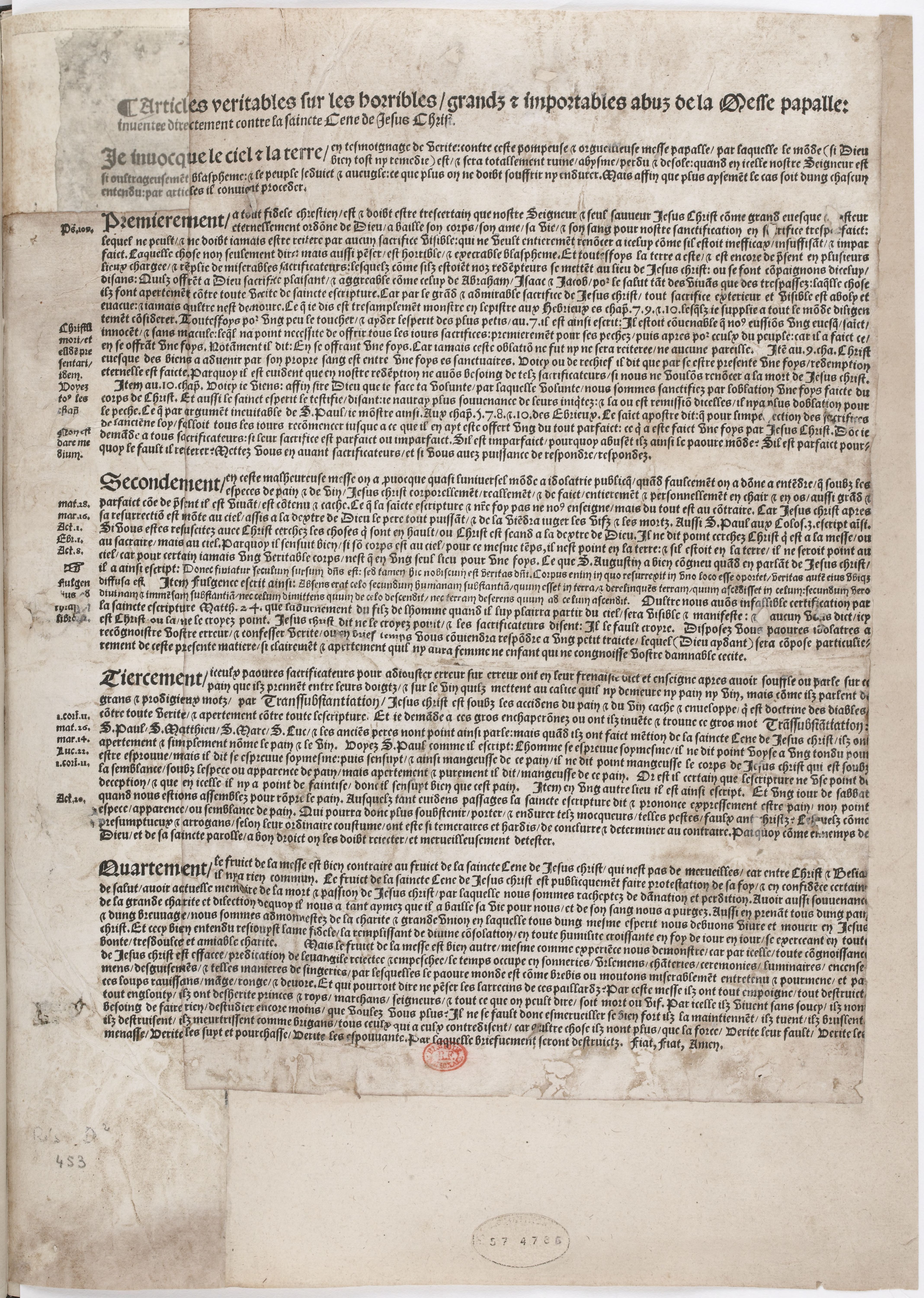
1539: the still unfinished chateau of Chambord is being shown by Francis I to Charles V.
1540s: the picture collection of Francis I being arranged at Fontainebleau.
1544: January: Marguerite of Navarre sends a letter of appreciation to her brother, king Francis I., who has sent her a crucifix, accompanied by a ballade, as a new year’s gift.
1547: death of Francis I.
1549: death of Marguerite de Navarre; death of Giampietrino.
1553: Jeanne d’Albret gives birth to Henry, the future French king Henry IV and first Bourbon king after the rule of the House of Valois.
1559: publication of the Heptaméron by Marguerite de Navarre.
1562-1598: French Wars of Religion.
1570: death of Francesco Melzi.
1589: Henry, grandson of Marguerite de Navarre and grand-grandson of Louise of Savoy, but by paternal descent a Bourbon, is becoming French king as Henry IV.
2015: an exhibition at the Château of Loches is dedicated to the 1539 meeting of king and emperor (see here).

»…in the evening at twenty-two o’clock we saw the Holy Sindon or Shroud«, Antonio de Beatis is writing in his travel account, his trip across Germany, France, the Netherlands and Northern Italy having enabled him to recall, as an eye witness, essential sights of the visual culture of Europe in 1517/18. These sights included, as said above, the Ghent Altarpiece, the Turin Shroud and also Leonardo da Vinci’s Last Supper at Santa Maria delle Grazie, Milan (picture of the Turin Shroud: Dianelos Georgoudis). Only the now so-called Turin Shroud, however, did apparently stimulate him to include a visual reproduction, a drawing, into the manuscript copies of his account.![]()
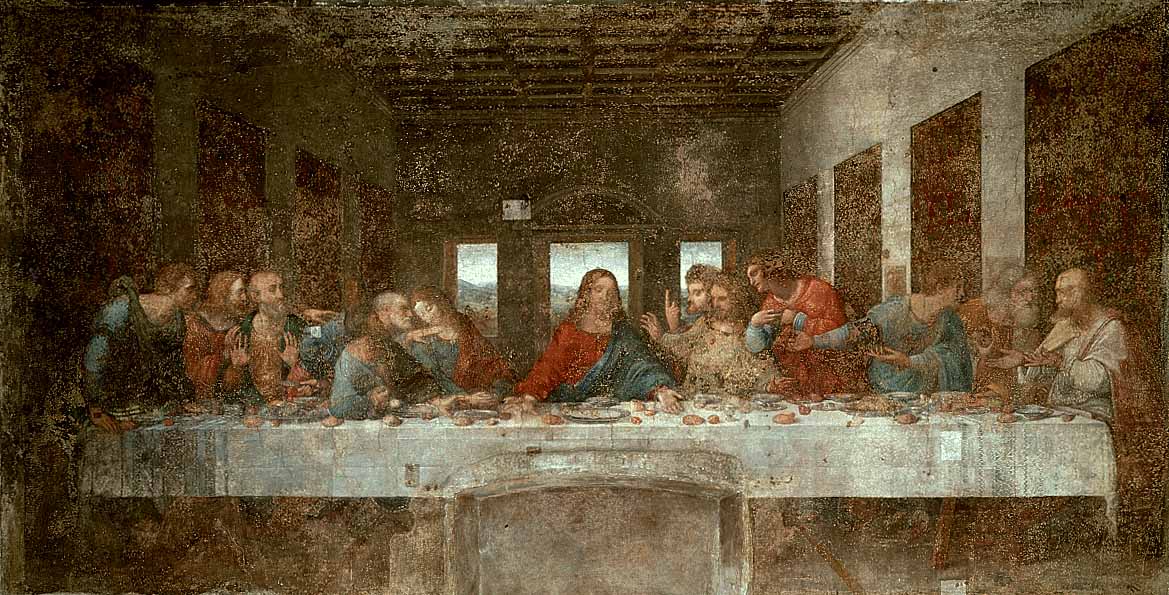
See also the episodes 1 to 29 of our New Salvator Mundi History:
Francis I and the Crown of Charlemagne
The Chronicles of Santa Maria delle Grazie
A Brief History of Digital Restoring
Learning to See in Spanish Milan
And:
MICROSTORY OF ART
ONLINE JOURNAL FOR ART, CONNOISSEURSHIP AND CULTURAL JOURNALISM
HOME
© DS